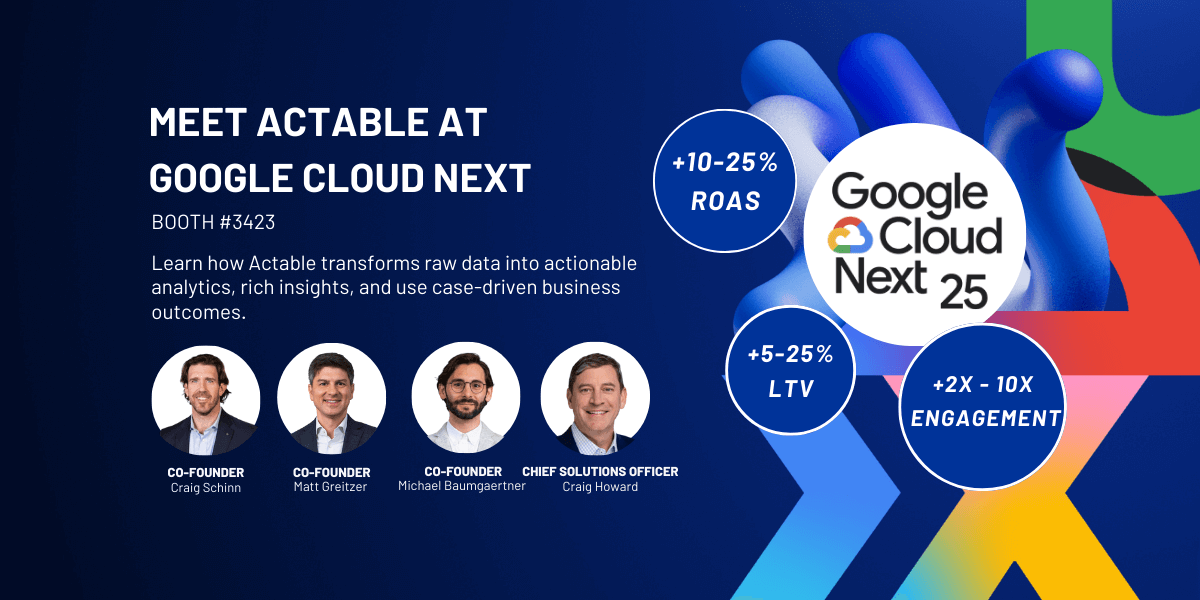As the Actable team gears up to visit Google Cloud Next, we can’t help but notice how busy the BigQuery team has been, releasing a slew of new native features within a month. These components drive home BQ’s rapid evolution into a one-stop shop for data management, analytics, and most recently AI and machine learning.
Actable regularly utilizes existing native BigQuery functionality like BQML for in-Warehouse machine learning and predictive modeling, Dataform for ELT processing of customer data, and development acceleration using pre-GA Gemini for BigQuery SQL code recommendations.
We’ve been evaluating these four new features that just went General Availability, and are excited to learn more about them at Next.
- What it is: This enables you to perform semantic similarity search on data stored in BigQuery. Think of it like finding similar documents or products based on meaning and context, not just exact keyword matches.
- Why it’s valuable: Vector search unlocks predictive analytics and gen-ai use cases. Advanced audience segmentation, highly personalized recommendations, deep customer journey analysis, large language model tasks like “Retrieval-Augmented Generation” (RAG), and anomaly detection scenarios like identifying potential fraud all become available with vector search. Being able to leverage BigQuery for this means that you can run training operations directly in your data warehouse instead of having to migrate data to a dedicated Vector DB.
2. Spark Stored Procedures in BigQuery:
- What it is: This integration brings the power of Apache Spark, a popular framework for large-scale data processing, directly into BigQuery.
- Why it’s valuable: Traditional data warehouses often require complex data pipelines or separate tools for tasks like data cleaning, transformation, and feature engineering. Spark procedures allow you to perform these tasks seamlessly within BigQuery using familiar tools like PySpark, Scala, and Java. This simplifies your workflow, reduces development overhead, and keeps your data in a single, secure location.
3. BigQuery Entity Resolution Framework:
- What it is: This framework tackles the challenge of disparate customer data. It allows BigQuery to connect with identity providers and resolve entity conflicts without physically moving or copying your data.
- Why it’s valuable: Often, customer information is scattered across different systems, leading to inconsistencies that hinder a holistic view. The entity resolution framework helps bridge these gaps by intelligently connecting records that belong to the same entity (e.g., a customer) even if they have variations in names, addresses, etc. This leads to cleaner data, more accurate analysis, and improved customer experiences.
- Additionally, the framework facilitates secure data sharing. By leveraging IdPs, you can collaborate with partners like TransUnion and share relevant customer data points without compromising security. Partners can access this data within your BigQuery environment with granular permissions, ensuring only authorized data is shared while maintaining privacy. This streamlines collaboration for initiatives like joint marketing campaigns or fraud detection.
4. Bidirectional Data Sharing with Salesforce Data Cloud:
- What it is: This feature eliminates data silos by enabling two-way data flow between BigQuery and Salesforce Data Cloud. It allows you to combine marketing, sales, and service data from Salesforce with other entities like loyalty programs or point-of-sale data stored in Google Cloud.
- Why it’s valuable: As marketing data consultants, one of Actable’s most common integrations involves integrating Salesforce data into our client’s data warehouse to gain deeper customer insights, personalize marketing campaigns, and accurately measure customer journeys. Being able to sync Salesforce data natively with BigQuery reduces the friction of licensing or building additional connectors.
Let us know what you are excited to check out at Next, and reach out if you’d like to meet up!









